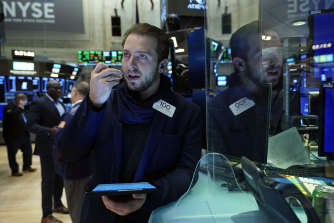By Damian Troise and Stan Choe
June 10, 2022 — 5.17am
Stocks are falling on Wall Street following the latest reminder that central banks now care more about fighting inflation than propping up markets.
The S&P 500 is 0.9 per cent lower in late trade, putting it on track for its ninth losing week in the last 10. The Dow Jones Industrial Average is down 1 per cent and the Nasdaq composite has shed 1.7 per cent. It sets up the Australian sharemarket for a negative start to the session, with futures at 4.55am AEST pointing to a slip of 19 points, or 0.3 per cent, at the open.

Wall Street is on track for another losing session.Credit:AP
The losses were even sharper across the Atlantic after the European Central Bank said it would raise interest rates next month for the first time in more than a decade. Another hike is set for September, possibly by double July’s increase, and the central bank will halt its bond-buying program next month.
It all marks a “sea change” in policy for the European Central Bank, according to Marilyn Watson, head of global fundamental fixed income strategy at BlackRock.
Loading
It’s part of a growing global tide where central banks are removing ultra-low interest rates that goose borrowing, economic growth and stock prices. Instead, they’ve swung their focus toward raising interest rates and making other moves to slow growth in order to knock down high inflation.
The risk is that such moves could cause a recession if they’re too aggressive. Even if central banks can pull off the delicate balancing act and avoid a recession, higher interest rates put downward pressure on stocks and all kinds of investments regardless.
The wide expectation is that the Fed will raise its key interest rate next week by half of a percentage point, the second straight increase of double the usual amount. Investors expect a third to hit in July.
European stocks sank immediately after the European Central Bank’s announcement, which came before US markets opened. French stocks were down only slightly before the announcement, but the CAC 40 index fell to a 1.4 per cent loss afterward. Germany’s DAX lost 1.7 per cent.
In the US, Treasury yields rose following the move from Amsterdam, though they wobbled a bit after that. The 10-year Treasury yield got as high as 3.09 per cent before paring back to 3.03 per cent, up from 3.02 per cent late Wednesday.
A report showed that slightly more US workers filed for unemployment last week than economists expected. That’s a potentially negative signal, but the overall number still remains low compared with history. Economists also said seasonal factors may have affected the most recent numbers, overstating some things due to the Memorial Day holiday.
Wall Street could be set for bigger swings on Friday after the US government releases its latest reading on the consumer price index. Economists expect it to show inflation slowed a touch to 8.2 per cent in May from 8.3 per cent a month earlier.
Higher gasoline prices have been putting a tighter squeeze on both consumers and households, upping the pressure on budgets. Crude oil prices were down about half a percent on Thursday, but they remain up by roughly 60 per cent for the year. Much of the jump is due to Russia’s invasion of Ukraine.
Lockdowns in major Chinese cities because of COVID-19 have added more pressure to global supply chains, though some of the impact could be easing. China reported its exports surged 17 per cent over a year earlier in May, up from April’s 3.7 per cent growth, as coronavirus precautions were eased in Shanghai and other cities.
Investors have been searching for signs that inflation may have already passed its peak, which would be good for markets because it could mean a less aggressive Fed. Speculation has been rising and falling that the Fed could take a pause on rate hikes at its September meeting, swaying with every data point on the economy.
Loading
Many investors are bracing for big swings to continue for a while given the deep uncertainties about where inflation and the Fed’s policies are heading. Stocks have been clawing back since hitting a bottom in the middle of last month, but the S&P 500 remains down more than 14 per cent for the year so far.
“Even if the market bottomed in May, we will see another sell-off at some point,” Nancy Tengler, CEO of Laffer Tengler Investments, wrote in a research note, “and some of us will feel worse than we thought we could because we thought it was over.”
AP


